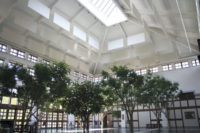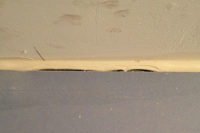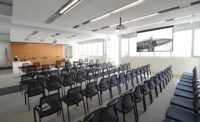Designing sound walls for multi-housing projects can be complex, especially when dealing with the problems of user satisfaction. Performance often relates to the basic quality of the material that makes up the wall, the installation quality, and how the various field conditions can compromise third party sound tested STC results.
It’s important to note that third party sound test reports may not adequately represent field conditions for the following reasons:
Acoustic Sealant: In a laboratory third party sound wall test, the perimeter joints are typically filled with acoustic sealant followed by an additional layer of foil tape and/or putty tape installed over the acoustic sealant. This completely eliminates the potential for any sound loss at the perimeter joints which is great for sound wall test reports but unfortunately does not adequately represent the as-built field condition.
In the field condition, that same acoustic sealant can shrink up to 40-plus percent of its original volume during the curing process and will have no additional foil or putty tape applied over the acoustic sealant. When acoustic sealant shrinks at such a high volume, it is prone to pull away from the weakest point of adhesion which is typically the edge of the drywall. If a slotted header track is used, then this gap can expose the open slots within the slotted track.
Sound testing was performed at Orfield Labs in Minnesota to see if random length 1/8-inch gaps in the acoustic sealant at the edge of the drywall would compromise the STC. Even though the gaps were small, it still resulted in a loss of 9 STC points.
Stud Spacing: Be sure to verify what the stud spacing is on the third party sound reports versus what is being built in the field. Test data found in the National Gypsum Sound Book shows that changing the stud spacing from 24 inch on center (STC 47 NGC 2386) to 16 inch on center (STC 44 NGC 2514) reduces the STC by 3 points.
Steel Stud Thickness: Many of the published sound reports will use the thinnest gauge steel stud available to get the best possible STC rating. However, in the field these thinner gauged steel studs have some limited applications. Example: door jambs, high walls, and any walls requiring support backing will typically require steel stud thickness of at least 20 gauge to support the load requirements. Test data found in the National Gypsum Sound Book shows that changing the steel stud thickness from 25 gauge studs (STC-60 RAL-TL07-168) to 20 gauge studs (STC-56 NGC 2013018) reduces the STC by 4 points.
Back to Back Electrical Boxes: In hotels that require the electrical boxes be placed in the same general area for mounting flat screen TVs, you can run into situations that have electrical boxes in the same stud bay of adjoining units. A comprehensive study has been conducted by the National Resource Council Canada on the effects of electrical fittings in the back to back position and they have found that you can have up to a 6 point STC reduction with back to back electrical boxes.
If, as a contractor, you find that your project has underperforming sound walls, what are your options?
You can troubleshoot potential issues by using the above mentioned targeted areas as a guide. But unfortunately without third party forensic testing to prove and pinpoint the sound loss areas it will just amount to finger pointing.
Evaluation of Wall Failure
When a wall fails to meet the rated acoustic standards, there are a number of ways in which to better understand the failure. These are some of the options:
Retest the wall with an NVLAP accredited lab to confirm that the first test was correct. (Many consultants, especially those who are not lab accredited, make mistakes in wall testing by not following all the formal requirements of ASTM testing.)
Perform flanking tests to determine where the failures are occurring. These are prescribed under the flanking test procedures of the ASTM standards that govern wall testing in the United States and Canada.
Perform advanced source localization testing to determine, with complex test instruments where the sound is flanking through or around the wall. Advanced source localization testing can be done in two ways:
- Sound Intensity Tests (SI)
- Acoustic Camera Beam Forming Tests (AC)
Orfield Labs have been providing dual microphone sound intensity testing since the 1980s as one of the first users of digital intensity in the U.S., and this is a measurement process where measures are taken at a set of grid points along the wall and the Intensity Analyzer converts those measurements into number maps, contour maps or other displayed graphs. These maps can be frequency limited before and after the measurement to take account of the frequency range that is producing the performance failure.
A more recent and more advanced method of defect measurement can be used via the use of Orfield Lab’s Norsonic Acoustic Camera. This Acoustic Camera consists of a microphone array (128 mics) and a computer is used as an optical camera and analyzer. The array must be designed so that all microphones in the array can be controlled for the measurement via beam forming. This provides a summary image (still or video) of the sound field corrected for microphone placement in the array.
These 128 microphones are in circular array on a flat vertical ‘dish’ which is aimed at the noise source (the wall) while high levels of sound are being generated in an adjacent room, like during field STC testing, emitting sound through the wall. A frequency range can be selected during the measurement or after, and the visual display will show in a multi-color contour image, the areas of the wall that are lower than other areas in transmission loss performance. Unlike sound intensity measurement, this display is instantaneous and dynamic, and the signal can be gated in time for capturing time windows of response. (SI can also do this.)
Tests can be used before STC tests so that you can ensure that the wall sample has been properly installed and has no significant leaks.
Wall failures are a serious concern for architects, contractors and manufacturers. There are many measurement processes that are burdened with the skepticism of all involved who often jointly observe the testing. With the Acoustic Camera, there is far less doubt about where the problems are coming from, as the pictures are usually quite clear in showing the areas of flanking failure. This can reduce the speculation about the problem and it can save considerable sums in supporting the basis of the failure so that responsibility can be determined quickly.
Closing: Proper preplanning in the beginning can help eliminate performance issues in the end.
Orfield Labs is one of the nation’s only multi-disciplinary building performance consulting lab in the U.S. and Canada. They provide consulting on design, research and testing in acoustics, vibration & sound quality, AV design, lighting & daylighting, thermal comfort and indoor air quality for most commercial building types. Orfield began in 1971, and their firm has been a federally accredited NVLAP acoustic lab with 3 reverberation chambers and an anechoic chamber, since 1995.
They have designed many projects around the U.S., and have consulted on and testified in many cases of building assembly failure on new projects. They have also provided many firms with research assistance on improving their products.
References
- National Gypsum Sound Book http://nationalgypsum.com/file/THESOUNDBOOK.pdf
- Orfield Lab’s Sound Testing Facility http://orfieldlabs.com/
- NRC-CNRC Effect of electrical outlet boxes on sound insulation of a cavity wall Nightingale, T.R.T.; Quirt, J.D.









Report Abusive Comment